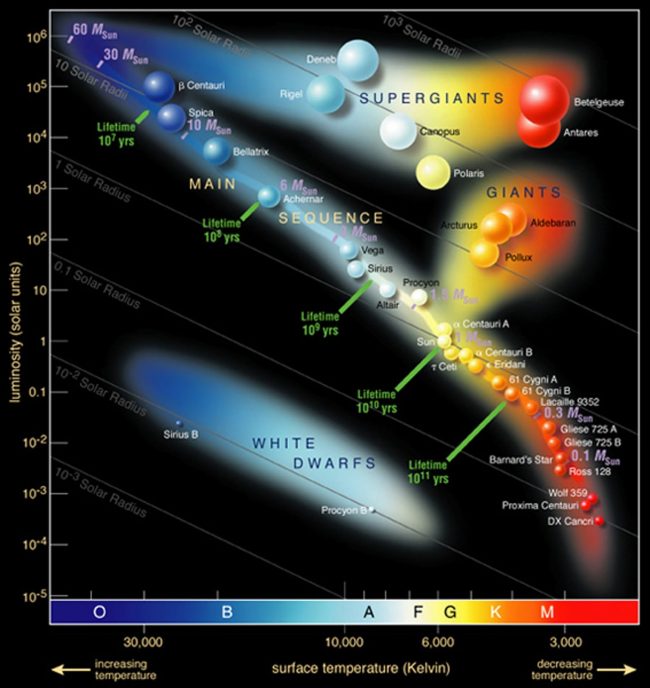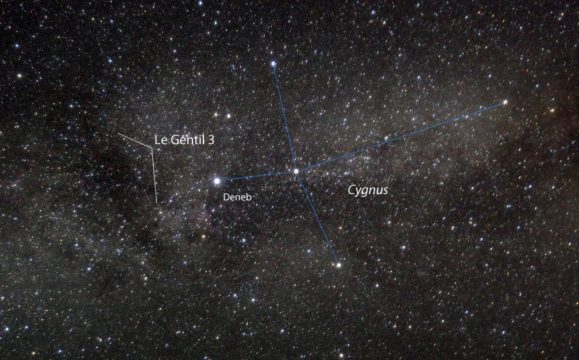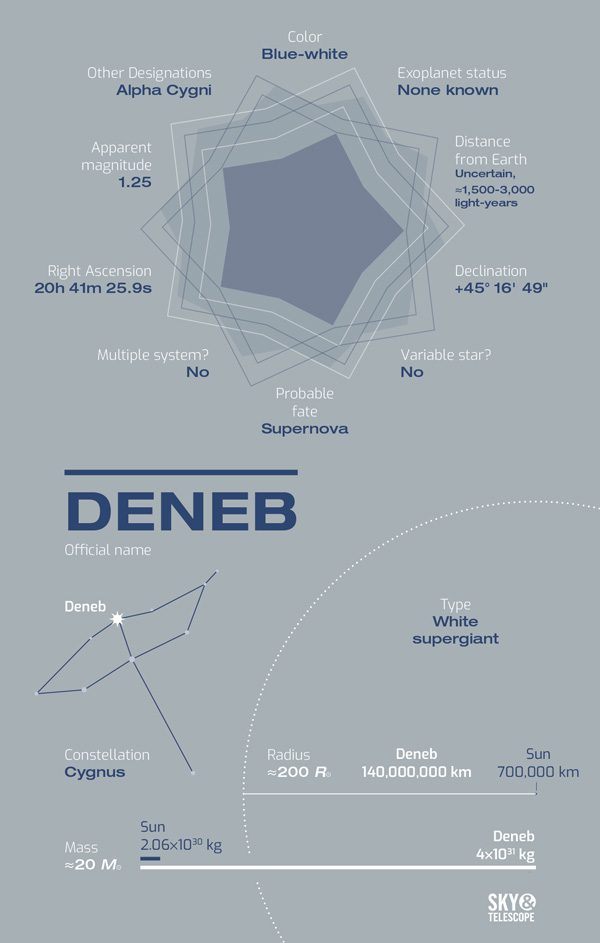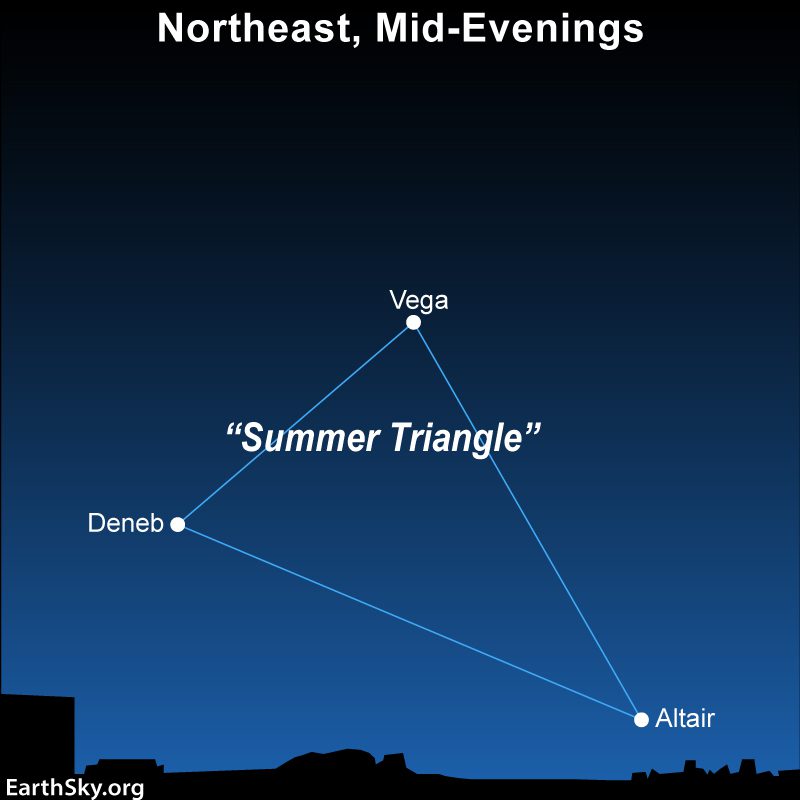Deneb The Bright, Distant Star –Facts, Features, and How We Know Its Distance
Deneb, one of the bright stars in the night sky, is a fascinating celestial object that continues to intrigue astronomers and stargazers alike. As the tail star of the Cygnus constellation and a prominent member of the Summer Triangle, Deneb holds a special place in the summer skies of the northern hemisphere.
Despite being light-years away, it remains clearly visible to the naked eye due to its extreme luminosity. Deneb’s exact distance is still a topic of scientific debate, highlighting the complexity of star distance measurement. This remarkable star offers valuable insights into stellar evolution, distance estimation, and the life cycles of massive stars in our galaxy.
Physical Characteristics of Deneb
Deneb is classified as a blue supergiant, specifically of spectral type A2Ia. This means it’s much larger and hotter than our Sun. Estimates suggest Deneb’s radius is about 200 times that of the Sun, and it emits approximately 196,000 times more light.Wikipedia+2Wikipedia+2Constellation Guide+2Constellation Guide+1Wikipedia+1
The star’s surface temperature is around 8,525 K, giving it a bluish-white hue. Its immense size and brightness place it among the most luminous stars known. Despite its distance, Deneb’s luminosity allows it to be visible to the naked eye.Constellation GuideWikipedia
Location and Visibility
Deneb resides in the Cygnus constellation, forming the tail of the swan-shaped pattern. It’s one of the three stars that make up the Summer Triangle, along with Vega and Altair. This triangle is prominent in the northern hemisphere’s summer sky.Wikipedia+5Astrotourism.com+5Space+5
In the United States, Deneb is best seen during summer evenings. It appears high in the sky, making it easy to spot even in areas with some light pollution. Its position near the Milky Way’s plane adds to its visibility and appeal.Sky at Night Magazine+1Wikipedia+1

The Distance to Deneb: How Far Away Is It?
Determining how far away is Deneb has been a challenge for astronomers. Early measurements from the Hipparcos Space Astrometry Mission suggested a distance of about 2,600 light-years. However, later analyses proposed it could be closer, around 1,500 light-years.EarthSky
This range in Deneb star distance estimates highlights the complexities in measuring stellar distances. Despite the uncertainty, Deneb remains one of the most distant stars visible to the naked eye. Its brightness continues to intrigue scientists and enthusiasts alike.
Methods of Measuring Deneb’s Distance
Astronomers use various star distance measurement methods to estimate distances. One primary method is parallax, which involves observing a star’s apparent movement against distant background stars as Earth orbits the Sun. However, for distant stars like Deneb, parallax measurements become less precise.
The Gaia space observatory aimed to improve distance measurements with higher precision. Yet, Deneb’s brightness posed a problem. With a magnitude 1.25, it exceeds Gaia’s optimal range, leading to star brightness saturation in its sensors. This saturation hampers accurate data collection for such bright stars.

The Origin and Naming of Deneb
The name Deneb originates from the Arabic word “dhaneb,” meaning “tail.” This is fitting, as Deneb represents the tail of the swan in the Cygnus constellation. Many star names have Arabic roots, reflecting the significant contributions of Arabic astronomers in the Middle Ages.
Deneb’s designation is Alpha Cygni, indicating it’s the brightest star in Cygnus. Its prominent position and brightness have made it a key reference point in various astronomical studies and observations.Wikipedia
Deneb’s Role in Astronomy and Navigation
Historically, Deneb has been vital for navigation and astronomy. As part of the Summer Triangle, it serves as a guidepost in the night sky. Navigators and astronomers have used it to locate other celestial objects and constellations.
In modern times, Deneb continues to be a subject of study. Its characteristics help scientists understand the life cycles of massive stars. Deneb’s potential as a future supernova provides insights into stellar evolution and the dynamics of our galaxy.

Interesting Facts About Deneb
Deneb stands out not just for its brightness but also for its distance. It’s among the most distant stars visible to the naked eye, with light taking over a millennium to reach Earth. This means when we observe Deneb, we’re seeing it as it was centuries ago.Cloudy Nights
The star is also a prototype for a class of variable stars known as Alpha Cygni variables. These stars exhibit slight changes in brightness due to pulsations in their outer layers. Studying these variations helps astronomers learn more about stellar interiors and dynamics.AAS Nova+1Wikipedia+1

How to Identify Deneb in the Night Sky
Locating Deneb is relatively straightforward. During summer months in the northern hemisphere, look for the Summer Triangle, a prominent asterism formed by Deneb, Vega, and Altair. Deneb is the vertex opposite Altair and to the left of Vega when facing south.Wikipedia+5The Planets+5NASA Science+5Astronomy Magazine+1Wikipedia+1
In the Cygnus constellation, Deneb marks the tail of the swan. The constellation stretches along the Milky Way, making it easier to spot in darker skies. Using star maps or mobile apps can aid in pinpointing Deneb’s exact location.
Table: Key Characteristics of Deneb
| Property | Value |
|---|---|
| Spectral Type | A2Ia (Blue Supergiant) |
| Apparent Magnitude | 1.25 |
| Estimated Distance | 1,500 – 2,600 light-years |
| Luminosity | ~196,000 times that of the Sun |
| Radius | ~200 times that of the Sun |
| Surface Temperature | ~8,525 K |
| Constellation | Cygnus |
| Part of Asterism | Summer Triangle |
Quote:
“Deneb’s brilliance is a beacon from the distant reaches of our galaxy, reminding us of the vastness and wonder of the cosmos.” – Astronomical Observer
Case Study:
A study analyzing data from the Hipparcos mission highlighted the challenges in determining Deneb’s exact distance. Initial estimates placed it at around 2,600 light-years. However, subsequent analyses suggested it could be closer, approximately 1,500 light-years away. This discrepancy underscores the complexities in measuring star distances, especially for luminous stars like Deneb.
Conclusion:
Deneb is more than just a bright point in the night sky. Its immense distance, luminosity, and role in both historical and modern astronomy make it a star of significant interest. As technology advances, we hope to uncover more about this celestial giant, deepening our understanding of the universe.
FAQs
What type of star is Deneb?
Deneb is a blue-white supergiant star located in the Cygnus constellation.
Why is Deneb so bright?
Deneb appears bright because of its high luminosity, despite being thousands of light-years away.
What is the spiritual meaning of the star Deneb?
Spiritually, Deneb symbolizes guidance, transition, and higher wisdom, often linked with cosmic journeys.
What type of star is the Polaris star?
Polaris is a yellow supergiant Cepheid variable star, located in the Ursa Minor constellation.
Which star is the brightest white dwarf?
Sirius B, the companion to Sirius A, is the brightest known white dwarf star.
Read our previous article: Blue Origin’s Blue Moon Lander Nears Demo Flight
